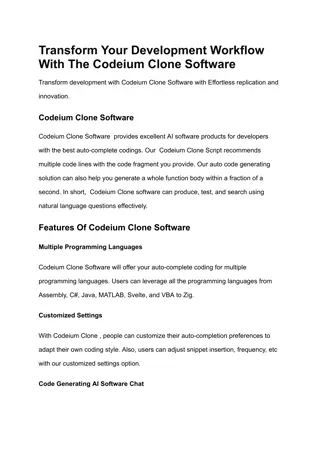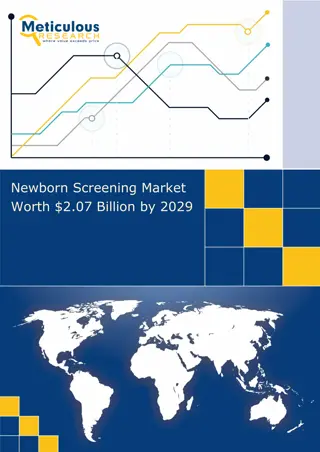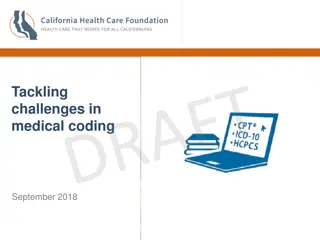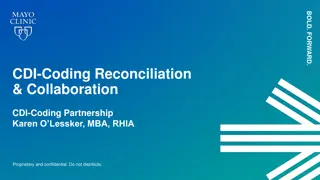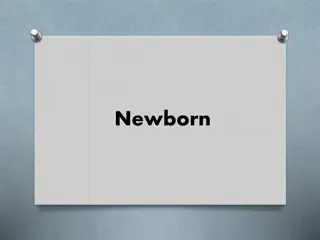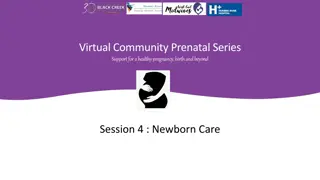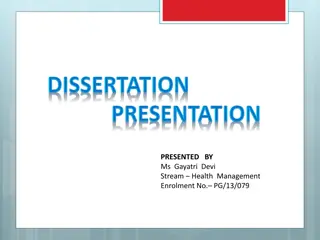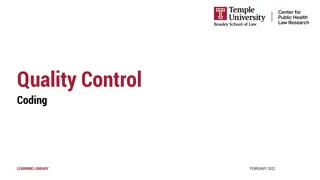Coding Guidelines for Newborn Conditions
Understand the coding guidelines for newborn conditions, including the identification of clinically significant conditions, the use of supplemental oxygen and bag ventilation, and the classification of congenital anomalies. Learn when to assign procedure codes and how to interpret the ICD-9-CM Official Guidelines for accurate reporting.
Download Presentation

Please find below an Image/Link to download the presentation.
The content on the website is provided AS IS for your information and personal use only. It may not be sold, licensed, or shared on other websites without obtaining consent from the author. Download presentation by click this link. If you encounter any issues during the download, it is possible that the publisher has removed the file from their server.
E N D
Presentation Transcript
Newborn Coding Guidelines Normal Newborn Findings Newborn Coding Clinic Abnormal Newborn Findings
Code all clinically significant conditions All clinically significant conditions noted on routine newborn examination should be coded. A condition is clinically significant if it requires: - Clinically evaluation; or - Therapeutic treatment or - Diagnostics procedures; or - Extended length of hospitals; or - Increased nursing care and/or monitoring or has implications for future health care needs. clinically significant conditions:
Acrocyanosis Erythema Toxicum Milia Nevus Simplex Mongolian Spot Innocent Murmurs
Question: A baby was delivered at 39.2 weeks with vacuum extraction. The delivery record indicates bag/mask ventilation and oxygen were provided for 1 minute. Should a procedure code for the bag ventilation and oxygen be reported? Question:
Answer: The use of supplemental oxygen and bag ventilation is an integral part of the care of a newborn. Do not assign additional codes for the brief use of bag/mask ventilation and oxygen. Some newborns may experience difficulty transitioning to extrauterine life and may require a period of supplemental oxygen, and spontaneous respirations can often be stimulated using a manual resuscitation bag and face-mask (BMV). In most cases, infants respond to these measures with no further interventions. In cases where they do not respond and mechanical ventilation is required, the mechanical ventilation codes should be used. Answer:
Microcephaly Strawberry Hemangioma Nevus Flammeus Staphylococcal Scalded Skin Syndrome Ankyloglossia (Tongue Tie) Clubfoot Hydrocele
Question: The provider documented nevus flammeus on the newborn s medical record. In ICD-9-CM, this condition is classified as a congenital anomaly. The ICD-9-CM Official Guidelines for Coding and Reporting, Section I, C, 15, a, 4, state that clinically significant conditions noted on routine newborn examination should be coded. However, Section I, C, 15, g, appears to indicate that any congenital anomaly is coded when documented. Which coding guideline should be followed when a congenital anomaly is documented on a newborn admission, without any apparent documentation indicating the condition was clinically evaluated, required treatment, required diagnostic tests, extended the length of stay, increased nursing care and/or monitoring or had implications for future health care needs? Question:
Answer: Assign code 757.32, Vascular hamartomas, for the nevus flammeus. It is appropriate to code congenital anomalies when identified by the provider, since they can have implications for further evaluation. Nevus flammeus, also known as port-wine stain, is a type of birthmark. The birth mark is caused by swollen blood vessels, and is commonly found on the face, neck, arms, and legs. It is usually diagnosed upon visual inspection of the skin. Port-wine stains or nevus flammeus located on the eyelids, forehead, or bilaterally on the face may be associated with seizures or glaucoma, and tests can be done to determine if there is increased intraocular pressure. Occasionally a skin biopsy may be required. Refer to the ICD-9-CM Official Guidelines for Coding and Reporting, congenital anomalies, Section I, C, 14. Answer:

 undefined
undefined












